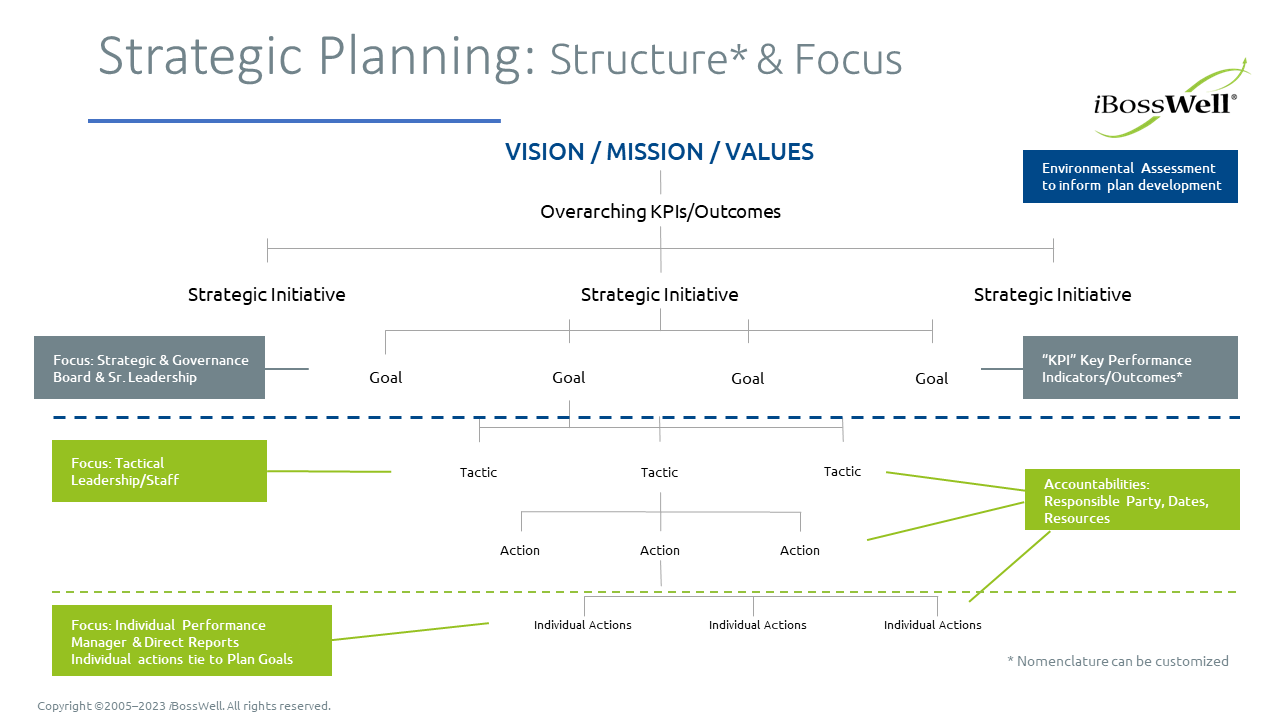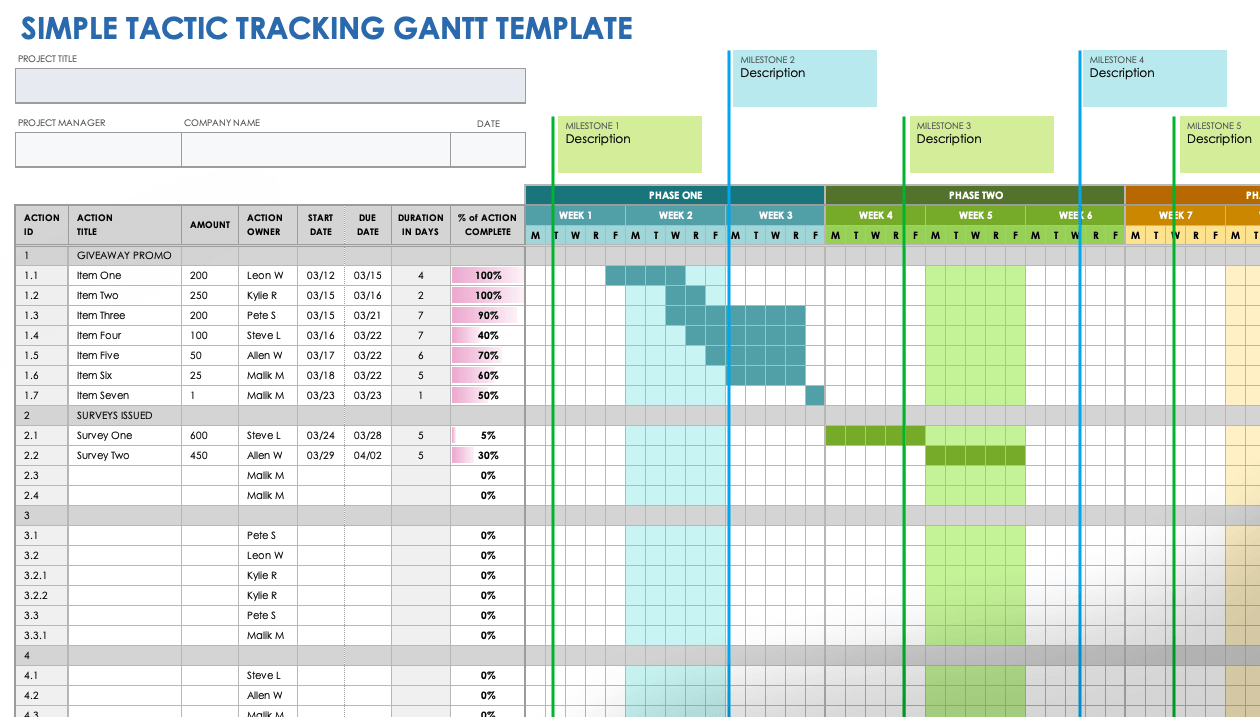The Difference Between Strategy and Tactics
Strategy is a long-term plan that outlines the goals of an organization. Tactics are the actions you take to achieve strategic goals. Strategy provides the big picture, and tactics are the immediate, short-term tasks you take to make it happen.
The Prussian military theorist and general Carl von Clausewitz once wrote, “Tactics and strategy are two activities that permeate one another in time and space but are nevertheless essentially different.”
To better understand the difference between strategy and tactics, refer to the following chart:
| Strategy | Tactics |
| Developed by upper management or strategic planners | Executed by tactical managers and teams |
| Provides the destination and guidelines for new or uncharted projects | Form the steps on the path to that destination |
| Sets you on the path to success or failure | Are neutral and can be the right action at the right time or the wrong time |
| Influences almost every aspect of a business | Are localized to the department, group, or team |
| Includes long-term actions | Include short-term actions |
| Describes tactics | Do not define strategy |
| Is difficult to change once set in motion | Are easier to adapt to changing circumstances |
| Represents a broad vision | Represent the actions that teams take daily |
| Thinks ahead | Respond to the moment |
| Is abstract | Are concrete |
“Tactics take time because it might mean writing a press release or coming up with a new logo or creating giveaways that you’ll have at an event,” says Whitney Keyes, a marketing communications consultant, speaker, and instructor for University of Washington’s Communication Leadership program. “Earlier in my career, I was pretty tactical. My family had a small business that I managed, and I worked with small businesses. I often thought of more tactical things like, ‘We should create a flyer, or we should put on an event or do some advertising.’ But I wasn't thinking about the next level up, the big picture of why we should do something. Those are wonderful tactical ideas, but how do they bubble up into something that's bigger that's going to generate revenue or attract more customers?”
Keyes says that working at big companies such as Microsoft developed her capacity to think strategically: “I learned to think of the bigger idea first, then all the fun stuff afterward.”
Actions can impress other people and give the appearance of progress. However, if they are random and do not connect back to a high-level, forward-looking view, they might not produce anything of value. As Sun Tzu wrote in The Art of War, “All men can see the tactics whereby I conquer, but what none can see is the strategy out of which victory is evolved.”
What Is a Strategy?
A strategy is a high-level plan aimed at achieving an end goal. It is rooted in an organization's core values and provides direction for key decisions. Generally stable over time, a strategy provides the framework wherein leadership develops tactical plans.
Organizations create strategies by gaining consensus on goals and taking into account departmental priorities. Typically, top leadership sets the strategy in both for-profit and nonprofit organizations, and front-line teams align their plans and activities accordingly. In larger organizations, individual departments and functional units may set their own strategies and metrics to align with the high-level strategy.
After researching competitors and customers, the organization establishes a strategy that offers an outward-facing and forward-looking perspective on its market position and role in the broader world. Creating a strategy also reveals your competitive advantage. Because the context of your organization can change, it’s critical to periodically review and update your strategy. The cross-functional process of defining a strategy influences project selection, resource allocation, prioritization, and contingency planning.
“Strategies are the ways and means in a commercial setting to beat your competitors,” explains Jim Stockmal, Managing Partner at SK Partners. “In a government setting, strategies fulfill the mission that was handed down by the governing bodies, whether it's Congress, state legislatures, or city councils. For nonprofits, strategies make sure the group is making the best use of the contributed revenues they get from their donors to fulfill the mission as efficiently and effectively as possible.”
Good strategy has a fixed goal and creates contingencies to overcome barriers. According to Richard Rumelt in Good Strategy/Bad Strategy, “The most basic idea of strategy is the application of strength against weakness. Or if you prefer, strength applied to the most promising opportunity.” Rumelt emphasizes that an effective strategy leverages an organization's strengths and turns weaknesses into avenues for growth and success.
A good strategy is characterized by the following elements:
- Alignment With Core Values: For a strategy to succeed and to garner full team support, it must align with an organization’s core values.
- Clear, Attainable Objectives: The strategy should promote objectives that are not only well-defined but realistically achievable within the given time frame and available resources.
- Correct Resource Allocation: An effective strategy allocates resources in a way that furthers the organization’s overarching aims.
- Outward-Looking: A good strategy considers the competitive and economic landscape, relative to the organization’s position within that context.
- Prioritization of Effort: A sound strategy takes the big picture into account when planning projects.
- Vision: A good strategy amplifies the intent behind the company’s vision and mission statements.
A good strategy also offers benefits that set the foundation for success:
- Facilitates Delegation: With a clear strategy, micromanagement becomes unnecessary because teams understand the overarching vision.
- Guides Planning: A good strategy acts as a North Star for planning all tactical activities.
- Informs Future Decisions: A well-defined strategy prepares an organization for both the challenges and opportunities that are likely to arise, guiding future decisions.
- Maintains Perspective: A good strategy places issues and setbacks in perspective, helping you focus on the road ahead rather than on obstacles.
- Streamlines Decision-Making: When you know your strategic objectives, you streamline the decision-making process because you are aware of what you are aiming for.
As illustrated in the diagram above, several interconnected components comprise the strategic planning process and converge to inform and shape the central strategy.
Get the full lowdown on how to write a strategic plan.
What Is a Tactic?
A tactic, or a strategic initiative, is a specific action or step aimed at achieving a particular goal. It is usually immediate and focused on short-term outcomes. Tactics are the practical means you use to carry out a strategy.
The word tactic comes from the Ancient Greek taktos, meaning arranged or organized. Today, the concept has evolved to signify more than organization alone; it is a detailed, purpose-driven action focused on the present. Tactics operate on a short timeline and are often flexible and reactive, but they serve the important function of contributing directly to an overarching strategy. They answer the questions of who, how, and when.
In a corporate environment, managers execute tactics, directing the team or group to complete specific tasks. These tactics focus on the efficient and effective use of time and resources. They often incorporate triggers that activate based on certain conditions or events.
Good tactics are measurable, aligned with the company mission, and time-bound. They consider the larger context while optimizing the use of time and resources. By directing actions toward a specific end goal, tactics reduce arbitrary actions and expedite decision-making. Furthermore, the results from these tactical efforts provide valuable data for future planning.
How Strategy and Tactics Relate to Each Other
Strategy provides a fixed point of guidance for an organization or initiative. Tactics, on the other hand, are the various paths navigated under this light or the actionable steps taken to reach a strategic destination.
“Strategies are the plans behind the actions that you want to take to achieve a goal,” says Karan Ferrell-Rhodes, author of Lead at the Top of Your Game and Founder of Shockingly Different Leadership, a global professional services firm. “The tactics are actually what you carry out, the decisions you make, and the behaviors that you exhibit to implement that ultimate strategy or plan. They're sister processes, if you will.”
Having just a strategy is like planning to plan: You’ll never realize your vision. “They’re both important, and they both weave together,” says Denise McNerney, President and CEO of iBossWell and former president of the Association for Strategic Planning. “If you just have tactics, it's like hamsters on the treadmill. They're running, but for what purpose?”
“I definitely think there should be a dance between the two,” says Keyes, “and in smaller businesses, CEOs and entrepreneurs need to dance between the two. It's really tough for them to sometimes get out of the weeds and get back to being more strategic.”
However, in a 2017 Journal of Management Reviews article, “Recovering the Divide: A Review of Strategy and Tactics in Business and Management,” David Mackay and Mike Zundel discuss how, in academic and professional management literature, tactics are often minimized, while strategy is vaunted as the way to success. “Tactics tend to be associated with lower military or organizational hierarchies, portrayed as opaque, bothersome minutiae that lack the clarity, rigor and significance of strategy formulations,” they write, adding that their usefulness is often restricted to that of a tool for enacting strategy.
Keyes explains how her experience at some companies reflects this bias. “There was all of this puffing of the chest that we have strategic thinkers and then there are doers,” she says.
Still, sometimes individuals favor strategic thinking over strategy. “What's challenging sometimes is people talk in those high-level terms, but they don't talk specifics,” says Keyes. “The tactical part is the roll-up-your-sleeves-now-we're-actually-gonna-do-it part where you map out the steps that will support that strategy.” The important thing to remember is that favoring strategic thinking without tactical execution can result in grand visions without the practical steps for realization, while emphasizing tactics without strategy can lead to aimless actions without clear direction or purpose. A balanced approach ensures that an overarching vision is complemented by efficient, purposeful actions.
McNerney uses the iBossWell diagram above to explain to new clients the difference between high-level strategy, indicated above the purple dotted line, and tactical implementation, everything below this line.
Above the dotted line are overarching objectives complemented by metrics. Below the dotted line, the diagram showcases specific actionable steps, such as adding night shifts or increasing staff. While using the diagram, employees should ensure they understand both the strategic vision and their role in the practical steps to provide context and direction to their efforts.
Strategy vs. Tactics Examples
Real-world distinctions between strategy and tactics exist across multiple industries, including social media, environmental management, small business, healthcare, retail, and more. In each sector, overarching goals are complemented by specific actions, highlighting the significance of a balanced approach to planning.
Social Media Strategy and Tactic Examples
Strategy and tactics go hand-in-hand when it comes to effective social media management. Social media strategies range from raising brand awareness to community building, while tactics include partnering with influencers or hosting monthly community challenges or events.
Here are some examples of social media strategies and the tactics that teams can use to achieve the strategic vision:
| Strategy | Tactics |
| Brand Awareness: Increase your brand's visibility to a wider audience. | Share visually appealing images or graphics that resonate with your audience. |
| Partner with influencers or celebrities for shoutouts. | |
| Run targeted ads to reach potential followers. | |
| Engagement: Encourage more interactions, such as likes, shares, and comments. | Host Q&A sessions to involve the audience. |
| Run polls or quizzes to get audience opinions. | |
| Share user-generated content as testimonials or to foster community spirit. | |
| Community Building: Create a loyal community around your brand or product. | Host monthly community challenges or events. |
| Recognize top community members or fans regularly. | |
| Set up private groups or forums for deeper interactions among community members. |
Environmental Management Strategy and Tactics Example
For successful environmental management, leaders need to design tactics that contribute to their strategic vision. One example of an environmental management strategy is the circular economy framework, which can be achieved with tactics such as rethinking supply chains.
Josh Prigge, Founder and CEO of Sustridge, a sustainability consulting firm, balances the use of strategy and tactics to find success for his clients and his business.
Prigge offers the following example of a strategy, along with several tactics that help achieve it:
- Strategy 1: Prigge uses the strategy of the circular economy framework, which focuses on using resources to their fullest potential and recycling them once they're done.
- Tactic 1: Rethink supply chains by switching to sustainable materials and using AI data analytics to find and reduce waste.
- Tactic 2: Use product-as-a-service (PaaS). In other words, instead of selling products, use the tactic of leasing or offering a subscription. For example, tech companies can let users subscribe to devices, taking back responsibility for their disposal.
- Tactic 3: Set sustainability goals for employees and offer regular training on sustainable practices.
Learn from experts about PR strategies, best practices, tips, and more.
Small Business Strategy and Tactic Example
Strategies and tactics in small business help you reach overarching goals. The strategy directs your decisions, and tactics provide targeted everyday activities to make goals a reality.
Academic and Business Strategist Dr. Vickie Cox Edmondson is the author of The Thinking Strategist: Unleashing the Power of Strategic Management to Identify, Explore and Solve Problems. She explains that strategy is a consistent set of decisions and approaches designed to meet financial and strategic objectives, attract stakeholders more favorably than competitors, and address industry threats, even if decision-makers vary. However, people might change tactics depending on their risk and uncertainty tolerance.
Edmondson offers an example of a strategy and three tactics she would use to improve the competitive positioning of a small business within the next two years:
- Strategy: Continuously monitor the environment and respond to competitive moves quickly.
- Tactic 1: Identify your strategic group of similar firms and conduct a SWOT analysis to identify competitive advantages and disadvantages of each firm.
- Tactic 2: Based on your findings, predict the competitive moves of each player and identify a response based on your firm’s competitive advantages and disadvantages.
- Tactic 3: Track the actual competitive moves of each player and make adjustments as appropriate given your firm’s strengths and opportunities.
Crisis Management Strategy and Tactic Examples
Crisis management strategies and tactics prepare an organization to manage a significant and unexpected negative event. These measures ensure the organization can respond swiftly, minimize damage, and communicate effectively with stakeholders during turbulent times.
Here are several examples of strategies and related tactics to use in crisis management:
| Strategy | Tactics |
| Preparation and Prevention Strategy: Prepare a response in advance to reduce the likelihood or impact of a crisis. | Create a Crisis Communication Plan: Write a clear communication plan that identifies key spokespersons, communication channels, and messages. |
| Conduct Regular Drills: Conduct periodic crisis simulations to test and train team members. | |
| Create a Stakeholder Map: Understand and list all important stakeholders, along with their concerns and their preferred communication channels. | |
| Response and Recovery Strategy: Manage a crisis as it unfolds and take steps to mitigate its impact, ensuring the organization returns to normalcy as quickly as possible. | Acknowledge the Crisis: Quickly acknowledge the crisis to demonstrate transparency and control. |
| Create a Centralized Command Center: Set up a centralized hub where decisions are made and information is disseminated. | |
| Update Stakeholders: Keep all stakeholders updated on the situation's progress and the steps being taken for resolution. | |
| Post-Crisis Evaluation and Adaptation Strategy: Learn and apply lessons to improve future preparedness and response capabilities. | Debrief and Analyze: After the crisis is resolved, gather all key personnel involved to evaluate the effectiveness of the response and identify areas of improvement. |
| Update Crisis Protocols: Based on the lessons learned, update and refine crisis management plans. | |
| Engage Stakeholders: Engage with stakeholders after the crisis to understand their concerns and rebuild trust. |
For more useful strategies and tactics to help you prepare for, survive, and rebuild after a setback, see this article on crisis management strategies.
Human Resources Development Strategy and Tactic Examples
Human resources (HR) strategies and tactics prepare an organization to nurture and optimize its workforce. These measures ensure the organization can attract, develop, and retain talent, fostering a harmonious work environment during times of change and growth.
Here are some strategies and tactics that an HR department might adopt:
| Strategy | Tactics |
| Talent Acquisition and Retention: Attract the best talent to the organization and keep retention rates high. | Update the Onboarding Process: Implement a comprehensive onboarding process that integrates new hires into the company culture. |
| Develop Employee Skills: Offer continuous professional development opportunities, such as workshops, courses, and certifications. | |
| Offer Employee Benefits: Establish a competitive benefits package, which could include health insurance, retirement plans, and wellness programs. | |
| Employee Engagement and Satisfaction: Ensure that employees are not only present at their jobs but are also emotionally and intellectually committed. | Gather Feedback: Conduct regular employee feedback surveys to gauge overall satisfaction and identify areas for improvement. |
| Improve Employee Relationships: Organize team-building activities and events, fostering camaraderie among employees. | |
| Implement Incentive Programs: Recognize and reward outstanding employee performance through incentive programs, such as bonuses, promotions, or public acknowledgments. | |
| Diversity, Equity, and Inclusion (DEI) Promotion: Prioritize DEI to ensure that the workplace values the differences and similarities of its employees. | Conduct Training Sessions: Provide regular DEI training sessions to ensure employees are equipped to create an inclusive environment. |
| Create Affinity Groups: Establish affinity groups or employee resource groups. | |
| Conduct Process Reviews: Periodically review hiring and promotion practices to ensure they are free from biases. |
Public Relations Strategy and Tactic Examples
Public relations (PR) strategies and tactics prepare an organization to shape and maintain a positive public image. These measures ensure the organization can proactively manage its reputation, even in the face of unforeseen challenges or scrutiny.
Here are some examples of PR strategy and tactic examples:
Strategy |
Tactics |
| Brand Awareness and Image Building: Enhance the organization's visibility and positioning in the public's perception. | Collaborate with influential media outlets and journalists to secure positive coverage and features. |
| Organize community events, sponsorships, or partnerships that align with the company’s values. | |
| Engage in content marketing, producing regular articles, blogs, and videos that highlight the company's achievements. | |
| Crisis Communication Management: Prepare for negative incidents or public perceptions to mitigate damage and uphold an organization's reputation. | Develop a crisis communication plan that clearly outlines roles and responsibilities. |
| Train spokespersons and key organizational figures to address media inquiries. | |
| Monitor media continuously to detect early signs of potential issues. | |
| Stakeholder Engagement and Relationship Management: Build and maintain strong relationships with stakeholders, including media, partners, and the public. | Host regular press conferences or media days to update the media on company developments. |
| Implement a feedback mechanism for stakeholders, such as surveys or focus groups. | |
| Maintain an active and engaging presence on social media, responding timely to inquiries. |
How to Measure Strategy and Tactics
To measure strategy, assess the progress toward long-term goals and overarching objectives using key performance indicators (KPIs). For tactics, monitor the immediate outcomes and specific actions taken, ensuring they align and contribute to the broader strategic goals.
“It can be really fun and easy for people to post a lot of content on social media or do other fun things, but if you're keeping an eye on your budget, you need to make sure that those activities are paying off,” says Keyes. “There are so many ways to measure, whether it's through focus groups or surveys or collecting qualitative or quantitative data.”
Remember that measures of success will differ depending on the industry or project in question. For example, the SpaceX rocket launch explosion might be deemed a failure based on a success metric such as “completing a mission without any malfunctions.” However, it can be considered a success using another metric, such as “gathering valuable data for future launches.” The setbacks encountered provided critical learning opportunities for future space travel missions.
Tools for Measuring Strategies
Teams can measure the effectiveness of strategies through key performance indicators (KPIs), such as time to completion, budget adherence, and scope fulfillment. Additionally, regular review meetings help to assess whether strategic outcomes meet the planned goals.
Here are some tools you can use to measure strategies:
- Balanced Scorecard: This tool provides a framework for monitoring organizational performance against strategic goals. Learn more in this all-inclusive article on balanced scorecards.
- Key Performance Indicators (KPIs): They serve as quantifiable metrics that reflect how well an organization is achieving its stated goals and objectives. Find out everything you need to know about KPIs in this guide to KPI dashboards.
- Objectives and Key Results (OKRs): OKRs are a goal-setting framework used to establish challenging, ambitious goals with measurable results. Find tips and step-by-step how-tos in this comprehensive guide to OKR scoring.
- SWOT Analysis: This tool assesses internal strengths, weaknesses, opportunities, and threats to inform strategic decision-making. To get started with SWOT analysis, check out one of these free, editable SWOT analysis templates.
Learn more in this comprehensive guide to OKRs and KPIs.
Tools for Measuring Tactics
To measure the success of a tactic, teams can use predefined key performance indicators (KPIs) that align with the desired outcome. The effectiveness of the tactic is determined by comparing the achieved results with these KPIs or set benchmarks.
“Tactics are tangibles,” says Keyes. “If we make squeezy balls that we're giving away at an event, did we give them all away? If you send out a press release, did that press release get picked up by the media outlets where you wanted it featured? Or did a report find it interesting enough to then follow up and write their own type of story? Tactics are very easy to measure.”
The method of measuring always depends on the tactic. Consider using project management software to set up a regular report. Schedule monthly meetings with managers to monitor these metrics and gather data for benchmarking and future planning. On a basic level, teams can set up a spreadsheet to capture low-level metrics and milestones.
Simple Tactics Tracking Gantt Chart Template
Download a Simple Tactics Tracking Gantt Chart for
Excel
| Google Sheets
Tracking metrics doesn’t have to be complicated. With this simple spreadsheet, you can track milestones, as well as qualitative and quantitative metrics, and changes over time. Customize this downloadable template to suit your project, and measure the progress of your tactics in an easy-to-use Gantt chart format.
Power Up Your Strategic and Tactical Approaches With Real-Time Work Management in Smartsheet
Empower your people to go above and beyond with a flexible platform designed to match the needs of your team — and adapt as those needs change. The Smartsheet platform makes it easy to plan, capture, manage, and report on work from anywhere, helping your team be more effective and get more done. Report on key metrics and get real-time visibility into work as it happens with roll-up reports, dashboards, and automated workflows built to keep your team connected and informed. When teams have clarity into the work getting done, there’s no telling how much more they can accomplish in the same amount of time. Try Smartsheet for free, today.







